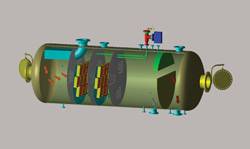Hamworthy Improves on Separator Performance
Hamworthy signed a contract with FPSO Owner OSX 1 Leasing B.V., a subsidiary of OSX Brasil S.A., for delivery of its newest generation Vessel Internal Electrostatic Coalescer (VIEC) technology to the FPSO OSX-1.
Upon completion of customization works currently in progress in , the FPSO OSX-1 will be delivered by OSX to its customer OGX Petróleo e Gás Ltda. under charter arrangements, for deployment in the basin, offshore . OSX and OGX are controlled by the EBX Group, owned by Brazilian entrepreneur Eike Batista.
Hamworthy’s VIEC technology has been designed to address problems often experienced with emulsion and capacity limits in separators. To enhance the speed and efficiency of the separation process, it forces small water droplets to merge and form larger, sediment drops more quickly.
The system will be installed in both the first stage separator and the test separator in order to improve processing of the heavy crude oil on the Waimea Field in the basin.
The delivery also includes Hamworthy’s new iPhase Water Profiler that measures the oil/water interface and provides accurate measurements of oil in water concentration inside hydrocarbon separators. The iPhase® profiler measures the electrical conductivity of the oil/water mixture surrounding each sensor, avoiding the use of radioactive sources.
“We are pleased to provide advanced technologies resulting from more than a decade of continuous R&D combined with operational experience from a number of deliveries since 2003 to improve oil and water separation performance for our customers,” said Hamworthy Oil & Gas Systems Director for Separation Technology, Trond Bynes, “We believe this technology will support future developments of heavy oil fields and strengthen our position in the world wide oil & gas market.”
In general, the VIEC approach effectively moves the use of electro coalescence upstream and into the production separators, improving separation performance from the outset. As well as increased oil & gas production and reduced chemical consumption, Hamworthy said the technology resulted in reduced fluid heating of high viscosity and heavy oils, less fresh water for desalting, reduced BS&W 1), and the removal of emulsified water and improved water quality before discharge.











